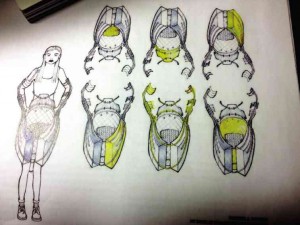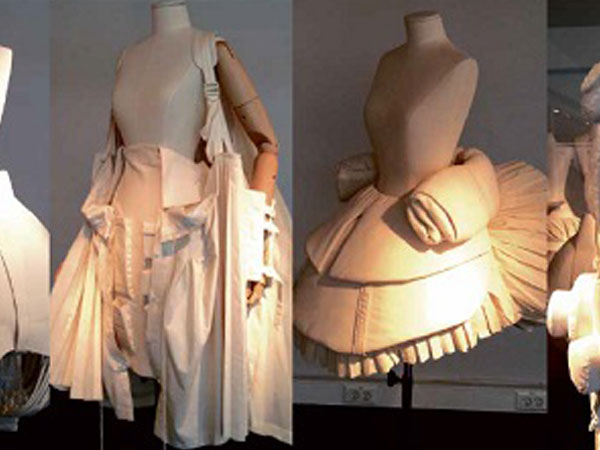
Aside from attending the vocational classes at Slim’s or Madonna’s School of Fashion, I and most of my peers are also considered “self-taught” or “self-educated.”
By “self-taught” I mean someone who started some 30 or 40 years ago, bought fabrics and sewing tools in Divisoria or Castle store, borrowed clothes from their mom or aunt to copy, and started experimenting until they got it right.
The “self-educated” were those who would commute to Alemar’s, Goodwill or even Peco (Philippine Education Company) to read more books on pattern-making and draping.
During leisure moments, they would read hardbound books about fashion icons and designers such as Audrey Hepburn, Grace Kelly and Greta Garbo, or designers such as Givenchy, Yves Saint Laurent and Paco Rabanne.
My generation’s icons were Thierry Mugler, Azzedine Alaia and Jean Paul Gaultier.
There were no websites to surf then.
As fashion school costs a lot, the most fortunate are those who are “formally educated,” who went through an associate degree or four-year Bachelor’s degree in a prestigious design and arts school abroad.
What works best
Which works best for the current generation?
This generation is quite lucky to have schools, vocational and degree programs right in Manila.
There are different methods, and what works best for you depends on what your goals are.
Here are three scenarios:
You want to start your own fashion house. You will be the next Inno Sotto. With so many foreign brands and successful designers, how can an aspiring one be competitive?
Given today’s mall and retail environment, do take the “formally educated” route—with work experience—before you start your label. Otherwise, your short-lived fame will need an amazing public relation person or company that does not come cheap.
Second scenario, you want to start your fashion company but you’re not interested in getting involved in the fashion industry; you just want a controllable size of business. You just want to design and produce clothes for a particular niche market.
You can take technical classes on garment construction and apprentice somewhere and do “self-study” on professional manufacturing processes.
From there, you can find subcontractors or manufacturers that do work for different brands.

Last, you want to work for an established fashion house and going to school is not an option. You will have to start from the very bottom, must be willing to work for free or minimum wage for a while.
Being “schooled” is no guarantee of landing a good-paying job or instant rewarding experience, but it will open doors for you. You still must look for internship somewhere.
’70s
With good work credentials and credibility, you will need a financier interested in your design and brand, if your family is not ready to invest in your dreams.
As a fashion designer, I tend to analyze fashion, where it came from and where it is going.
In the ’70s, I imagined how futuristic our clothes would be in 30 to 50 years. With high-technology fabrics, clothing is much easier to maintain now and is designed for mobility.
But in terms of design, I’ve always thought that textile-related fashion didn’t go as fast-forward or as futuristic as architecture and furniture design. Maybe, anything designed for the body can’t take the drastic change and abuse that technology or the trends could produce, while the earth can take the abuse of more and more high-rises and constructions?
Not to deviate from fashion, fashion designers in fashion capitals have always been using history as reference.
Rei Kawakubo
The last designer who was influentially radical was Rei Kawakubo, the Japanese avant-gardist and creator of the trailblazing brand Comme des Garçons. In the early ’80s, she turned the fashion scene totally in a different direction, inventing deconstruction and use of distressed fabrics.
Her colors were predominantly black.
Today, who seem to be moving forward and are innovative are Belgian designers.
The first batch of successful designers was called the Antwerp Six. This refers to the influential avant-garde fashion designers who graduated between 1980-1981.
In 1986, the breakthrough happened. The Antwerp Six rented a truck and went to the London Fashion Fair with their collections: Dries Van Noten, Ann Demeulemeester, Dirk Van Saene, Dirk Bikkembergs, Marina Yee and Walter Van Beirendonck.
Their fashion collections were radical and distinct. This established Antwerp as a notable location for fashion design.
Martin Margiela is another Belgian contemporary, who had moved to Paris. He worked for Jean-Paul Gaultier in 1985-87. He started his own label in 1989. He was also the creative director for Hermes from 1997-2003.
Then he went into partnership with another successful garment entrepreneur that lasted for years.
Galliano to Raf
He is known to be the most discreet designer, shunning publicity.
Replacing John Galliano, another known Belgian is Raf Simons, now the creative director for Dior women’s line, while Kris Van Assche is designer for Dior menswear. His experience of the incongruity of wearing black tie in an art fair held on the beachside actually struck him and has influenced him in mixing the formal and the informal at Dior.
My curiosity about today’s breed of fashion designers drove me to visit Antwerp, a city I found to be understated, relaxed and elegantly casual both in its lifestyle and attitude. I was lucky to catch the exhibit of first-year students of the Royal Academy of Arts, Fashion Program.
The topic was the study of the shape of a skirt—a prerequisite to pass the first year of their fashion degree.
The “Shape Study of a Skirt” focused on three artistic subjects: pattern-making, graphics and fashion design.
Every freshman had to hurdle the first obstacle course in designing a skirt. The design must be related to his concept of fashion.
3D
The musts: the skirt, shaped in relation to the body, done in two and a half months; must be one skirt that can function, be mobile and wearable, even if it doesn’t look like it does.
The students were encouraged to be as creative and bold to experiment—using a uniformly coarse cotton, very much like our katcha but a thousand times more dense.
In making their project, some couldn’t yet handle the sewing machine, the skirts instead were impeccably hand-sewn.
Not to forget the last requirement: It must be 3D.
Even if they looked like works of art, they were classified as “design,” and they were designed to be mobile. Design had function.
It was a humbling experience to see the impeccable work of these young students. One was reminded that good design is the application of basic principles.
E-mail lulutangan@gmail.com











































